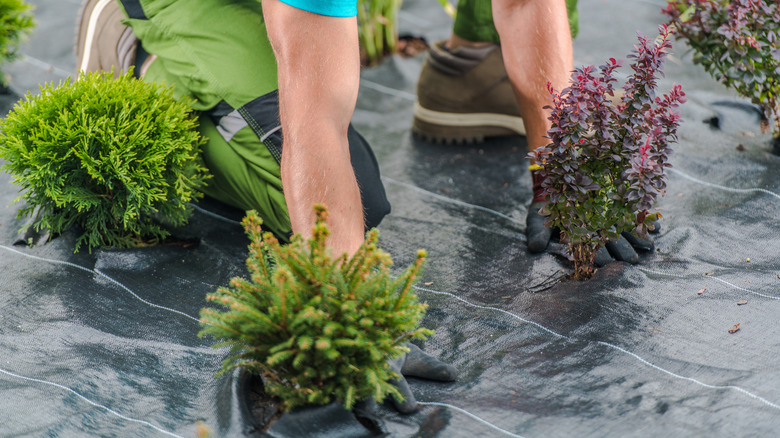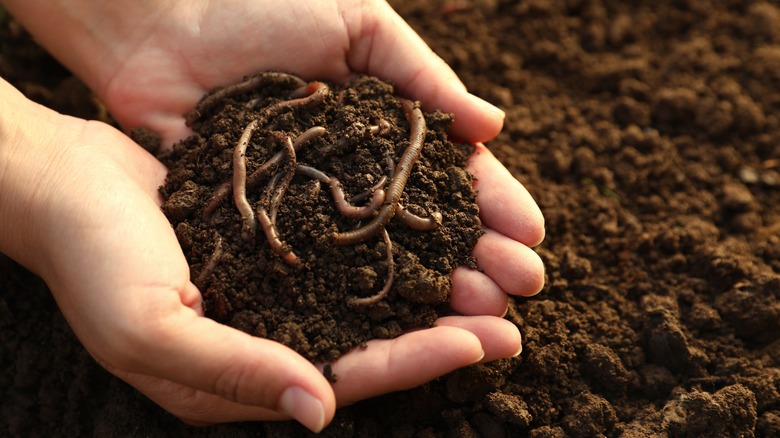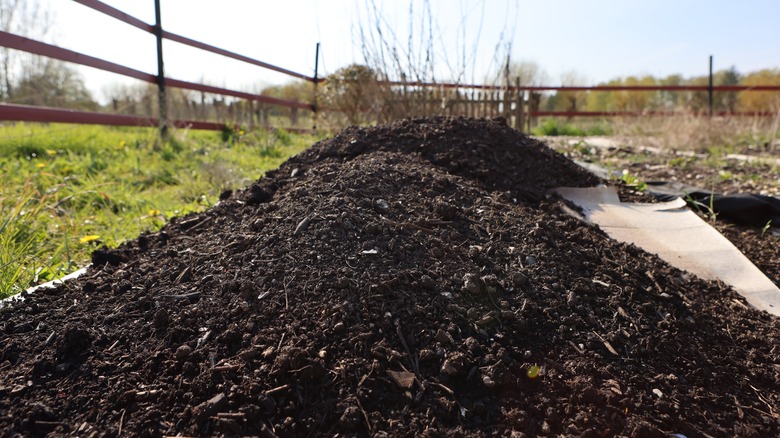The Downsides To Using Landscape Fabric You Haven't Considered
We may receive a commission on purchases made from links.
For those trying to control weeds without sprays, landscaping fabric might seem like a dream. After all, the best types of landscape fabric can keep weeds at bay, but using this material can cause some problems. While the fabric is typically made of a polypropylene woven mesh that is somewhat porous and will let your plants grow while helping to suppress weeds and reducing erosion, there are some downsides you may not have considered. Landscaping fabric cannot entirely prevent weed growth. It also limits the amount of water and air that reaches the ground, can reduce the health of your soil overall, and makes it difficult to move plants around.
So, how can it both suppress weeds and allow weed growth? Landscaping fabric sitting over the ground will keep weeds from popping up from underneath, but that doesn't stop weeds from growing on top and spreading that way. Organic material accumulating over time on the landscaping fabric or a medium you place there, like mulch, can allow weeds to grow, rooting into the fabric itself. If that happens, you not only have the other downsides to deal with, but one of the main reasons for installing the fabric to begin with actually creates a bigger problem. Removing weeds from the fabric without ripping the material is difficult and often leaves room for more weeds to grow.
Keeping your soil and plants healthy
While you could choose a product like Sandbaggy Biodegradable Landscaping Fabric or something similar, most are made of polypropylene, a commercial plastic created from petroleum. Are they safe to use in places like your vegetable garden? While the Environmental Protection Agency lists the substance in the safer choice category, you personally might not want the chemical near your edible plants. Speaking of the health of your plants and soil, keep in mind that while landscaping fabric is meant to be somewhat porous, decomposing materials like mulch and soil can clog the material, restricting both water and airflow.
If the water and air can't reach the soil, it will not only affect the health of your plants but also the ground. Without moisture and air, earthworms won't frequent the area and do their job of aerating and increasing the health of your soil. Plus, organic matter that would normally break down, mix with the soil, and improve the activity in the soil and its structure will be stopped by the barrier created by the landscaping fabric. In addition, gardeners who like their plants and flowers to naturally spread might find this material may prevent that from happening.
Other issues with landscaping fabric (and what to use instead)
Using landscaping fabric in certain cases is a good idea, especially areas you can't easily mow or maintain or along pathways with little foot traffic. But using it in your garden where you might want to move plants around presents a problem. When you lay down the fabric, you create holes in the material's surface for your plants. Digging them up from the ground while keeping that hole intact is difficult, so you need to create larger holes to remove the plant properly. Making your garden look different can also be a challenge because you already have holes in place. Ripping new holes or expanding them will eventually end with the fabric in tatters, leaving more openings for weeds to grow. And if you have an irrigation system covered by the fabric, you risk hitting the lines by digging blind.
If you find that the downsides of using landscaping fabric outweigh the benefits, there are alternatives to using the material in your outdoor space to prevent weeds. Laying down 3 to 6 inches of pine straw, compost, arborist chips made of ground trees and branches, or leaf mold a couple of times a year can suppress weeds while increasing your soil's health. You could also use newspaper or cardboard to keep weeds from invading your space. Both of these options decompose over time, don't harm the soil, and suppress weeds. Be sure to avoid newspaper with gloss coverings and coated cardboard.


